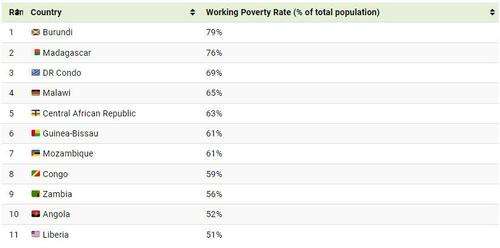
Poverty is often associated with unemployment - however, millions of working people around the world are living in what’s considered to be extreme poverty, or less than $1.90 per day.
Thankfully, the world’s population of poor workers has decreased substantially over the last few decades. But how exactly has it changed since 1991, and where is the majority of the working poor population living today?
This graphic by Visual Capitalst's Gilbert Fontana uses data from the International Labour Organization (ILO) to show the regional breakdown of the world’s working poor, and how this demographic has changed in the last few decades.
From Asia to Africa
In 1991, about 808 million employed people were living in extreme poverty, or nearly 15% of the global population at the time.
As the graphic above shows, a majority of this population lived in Eastern Asia, most notably in China, which was the world’s most populous country until only very recently.
However, thanks to China’s economic reforms, and political reforms like the National “8-7” Poverty Reduction Plan, millions of people in the country were lifted out of poverty.
Today, Sub-Saharan Africa is the region with the world’s highest concentration of working poor. Below, we’ll take a closer look at the region and zoom in on select countries.
Zooming in on Sub-Saharan Africa
As of 2021, 11 of the 49 countries that make up Sub-Saharan Africa had a working poverty rate that made up over half their population.
Here’s a look at these 11 countries, and the percentage of their working population that lives in extreme poverty:
Burundi is first on the list, with 79% of its working population living below the poverty line. One reason for this is the country’s struggling economy—Burundi has the lowest GDP per capita of any country in the world.
Because of the economic conditions in the country, many people struggle to meet their basic needs. For instance, it’s estimated that 40% of urban dwellers in Burundi don’t have access to safe drinking water.
But Burundi is not alone, with other countries like Madagascar and the Democratic Republic of the Congo also having more than two-thirds of their working population in extreme poverty. Which countries will be able to able to lift their people out of poverty next?
Poverty is often associated with unemployment – however, millions of working people around the world are living in what’s considered to be extreme poverty, or less than $1.90 per day.
Thankfully, the world’s population of poor workers has decreased substantially over the last few decades. But how exactly has it changed since 1991, and where is the majority of the working poor population living today?
This graphic by Visual Capitalst’s Gilbert Fontana uses data from the International Labour Organization (ILO) to show the regional breakdown of the world’s working poor, and how this demographic has changed in the last few decades.
From Asia to Africa
In 1991, about 808 million employed people were living in extreme poverty, or nearly 15% of the global population at the time.
As the graphic above shows, a majority of this population lived in Eastern Asia, most notably in China, which was the world’s most populous country until only very recently.
However, thanks to China’s economic reforms, and political reforms like the National “8-7” Poverty Reduction Plan, millions of people in the country were lifted out of poverty.
Today, Sub-Saharan Africa is the region with the world’s highest concentration of working poor. Below, we’ll take a closer look at the region and zoom in on select countries.
Zooming in on Sub-Saharan Africa
As of 2021, 11 of the 49 countries that make up Sub-Saharan Africa had a working poverty rate that made up over half their population.
Here’s a look at these 11 countries, and the percentage of their working population that lives in extreme poverty:
Burundi is first on the list, with 79% of its working population living below the poverty line. One reason for this is the country’s struggling economy—Burundi has the lowest GDP per capita of any country in the world.
Because of the economic conditions in the country, many people struggle to meet their basic needs. For instance, it’s estimated that 40% of urban dwellers in Burundi don’t have access to safe drinking water.
But Burundi is not alone, with other countries like Madagascar and the Democratic Republic of the Congo also having more than two-thirds of their working population in extreme poverty. Which countries will be able to able to lift their people out of poverty next?
Loading…







